
The Project Gutenberg EBook of An Alphabet of Quadrupeds, by Anonymous
This eBook is for the use of anyone anywhere at no cost and with
almost no restrictions whatsoever. You may copy it, give it away or
re-use it under the terms of the Project Gutenberg License included
with this eBook or online at www.gutenberg.org/license
Title: An Alphabet of Quadrupeds
Comprising descriptions of their appearance and habits
Author: Anonymous
Release Date: July 29, 2012 [EBook #40363]
Language: English
Character set encoding: ISO-8859-1
*** START OF THIS PROJECT GUTENBERG EBOOK AN ALPHABET OF QUADRUPEDS ***
Produced by Jason Isbell, Katie Hernandez and the Online
Distributed Proofreading Team at http://www.pgdp.net

Frost's Juvenile Series.

THE MENAGERIE.
COMPRISING DESCRIPTIONS OF THEIR
APPEARANCE AND HABITS.
WITH NUMEROUS ILLUSTRATIONS.
PHILADELPHIA:
LIPPINCOTT, GRAMBO, & CO.
Entered according to Act of Congress, in the year 1852,
BY LIPPINCOTT, GRAMBO, & CO.,
in the Clerk's Office of the District Court of the United States,
in and for the Eastern District of Pennsylvania.

APE.
ALPHABET OF QUADRUPEDS.
Apes play many odd tricks, and try to act like men, for they are very fond of imitating every thing they see. They are also very mischievous, and sometimes spiteful, so they should be either tied up in a safe place or well watched.
Apes are a species of monkeys. They live in a country called Africa, where there are a great many forests, and where the trees are much larger than any in the settled parts of America. The apes can climb to the top of the very tallest8 trees, and cling to the branches in safety. They are very quick in their motions, and can fling themselves from tree to tree with great readiness, holding on with their long arms and legs. In their native woods, they are very wild; they go on all fours; and sometimes visit the Negroes' huts and fight hard battles with the inhabitants, throwing sticks and branches with great dexterity. They are usually of a dull brown color, but some are black, and others grey. They should be fed upon bread soaked in water, and any kind of fruit that may be convenient to give them; they are very fond of nuts and biscuit, both of which may be given them in moderation.

The bear is found in Europe and North America, but it is among the icy regions around the North Pole, that he attains his greatest size and fierceness. One of his principal modes of attack is the employment of his fore-legs in hugging his enemy, and few creatures can resist the crushing embrace of a large bear.
The people of the cold countries, where he mostly lives, make bedding and clothing of the skins, and either eat the fat or melt it into oil for their lamps. Bears, when at rest, are in the habit of constantly sucking their paws, which12 curious custom has puzzled many wise men to explain.
The bear is a good swimmer, and often takes to the water; he climbs well, but in descending trees always comes down backwards. His sight is sharp, and his hearing and smelling is excellent. He walks easily on his hind-legs, and in that position can support heavy burdens. Though his gait is awkward, he can, if he pleases, go at a great pace. He is said to grow to about his twentieth and live to his fiftieth year. Some bears are black, others brown, and a few grey, but those in cold countries are always white.

The cow is a very useful, and well known animal. The cow furnishes us with an abundance of good sweet milk, which we put into our tea and coffee, or make into butter and cheese. The flesh is most excellent food, and is called beef. England is a famous country for beef, which is of such a good quality that the people have an old song about it, called the "Roast beef of old England." The hide is made into leather, and is much used in the making of shoes.
The cow is a very quiet animal, and will hurt no body, it feeds upon grass,16 which it swallows and brings up again before digesting it, and chews a very long while, and on that account is called a ruminating animal.
Cows are of different colors, some red, white, black, and others spotted. The cow will live to the age of fourteen or fifteen years, and its age may be known by the rings or knots on its horns, for a new ring grows every year. A great many country people are employed in selling milk to the people of large cities and towns, and are called "milk people." Before the white people came to America there were no cows, but now they are raised in great numbers, especially in the eastern country.

Dogs are most faithful, attached creatures. They are of all sizes, from the large Newfoundland dog, as big nearly as a donkey, down to the little lap-dog, no bigger than a kitten. Dogs are of various colors, and their skins of all kinds, the hair sometimes smooth and close, like a grey hound's; sometimes very rough and shaggy, as in the Scotch terrier; sometimes smooth and flowing, like silk, as in a spaniel.
They are soon taught to be obedient, and become very clever. The shepherd's dog knows every sheep in the flock. The20 house dog knows the sound of his master's footsteps. The Newfoundland dog will rush into the water to save any one from drowning. There are many interesting stories about dogs, which will please you very much to read when you are older and better able to understand them.


How heavy and clumsy the elephant looks! yet he is very active, and able to do many things with neatness. If you hold a sixpence in your hand, he will take it up in his large trunk, and place it where the keeper tells him. With the same trunk he is able to tear up large trees, and to strike so hard that the blow would kill a man. In foreign countries he is used to ride upon, as we ride upon horses. He is a very good swimmer. He is born chiefly in warm climates. His tusks are ivory, and are very useful for handles of knives, and many other24 things. His trunk serves him instead of a hand to feed himself with, and to hold and carry what he pleases.
He is very clever, and soon learns to do whatever he is taught. His temper and nature are kind, but when he is teased he becomes very fierce. He eats grass and hay, but no flesh.
Below is an elephant hunt.

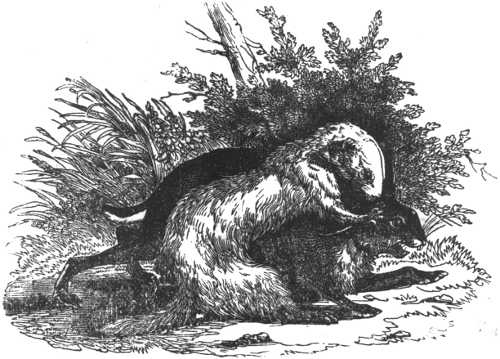
This is the name of an animal found in the northern and middle states of our country, and in Canada. He is called the fisher, by the hunters, probably from his frequenting the lakes and river shores. But he does not catch fish like the otter. He robs the traps of the hunter of their captured or dead game, and he kills squirrels, rabbits, and wood chucks. In the picture he is represented as killing a rabbit.
The fisher was formerly abundant in the state of New York, but he is seldom found there now. He was greatly detested28 by the hunters, on account of his robbing their traps of beaver and other valuable game. His flesh is unfit for food, and his fur is of very trifling value.


We have not many goats in America, but you will sometimes see them about the houses of poor people who live on the out-skirts of large towns and villages. They abound in many foreign countries, chiefly those which are wild, and have high hills and mountains. These, let them be ever so high, the goat climbs very nimbly and safely. The goat is a very useful creature. Its young are called kids, and its flesh is very good to eat; out of its skin we make good leather for shoes and gloves. The goat's milk is pleasant to drink, and to make cheese from. It eats32 herbs and delights to nibble the bark of trees. You will often read in the Bible, that goats in ancient times were offered as sacrifices. In Switzerland they have a kind of wild goat, called the chamois. The cut below represents some Swiss hunters pursuing the chamois over rocks and mountains.


The hyena is one of the most fierce and disagreeable of all animals. The hyena is by nature a nocturnal animal; that is, it seeks its prey by night, and consequently during the day it remains in a state of repose. The hyena has been unfairly represented to be perfectly untameable on account of its great ferocity. If properly treated, however, and well fed, it is far from being savage or dangerous.
It possesses a great propensity for putrid and buried carcasses, which it will hunt, and dig for, and devour with disgusting36 greediness. Unlike many other animals, the hyena is an unsociable animal, for it lives a solitary life among rocks and ancient ruins. There are two kinds of hyenas, the spotted and the striped. The figure below represents the striped, and the other represents the spotted hyena.


The ibex is an animal of the goat kind, and inhabits the mountainous districts of the south of Europe, it is the most graceful of all its tribes; it is extremely active. It is very wild, and difficult to be shot, as it always keeps on the highest points. The horns of the ibex are large and knotty, its skin is of a yellow color, and its beard short and black. The chase of the ibex, although it is not a very powerful animal, is attended, at times, with considerable danger; it has been known, when driven hard, to run full-but at the huntsman,40 and force him over the rock, although in doing so, it has at the same time, sacrificed its own life, falling headlong with its pursuer. The ibex is said to be a short-lived animal. Its flesh is much esteemed, and its skin is very thin.
Below is a picture of a bear pursuing a male and female ibex.


This odd-looking creature has been also called the two-legged rat; its fore-legs being so extremely small that they can hardly be seen, while the hind-legs are of enormous length. The tail is long and tufted at the end. Its general appearance closely resembles the rat. Instead of walking or running on all fours, it leaps, or hops, on the hind feet, making great bounds, and only uses the fore-paw for burrowing, or for carrying food to its mouth, like a squirrel. These curious little animals live in holes which they dig under44 ground. They are gentle, harmless, and not at all timid. Their dwelling places are very quiet, for they never fight or quarrel with one another, like some very bad children I could tell you about.


This curious animal, called a Kangaroo, hops on his hind-legs, which are very long; his fore-legs are short, and he has a very long hard tail. Kangaroos herd together in great numbers, for they are very timid creatures. At the least alarm they will run away, and leap over high bushes. They use their short fore feet for digging, and putting food in their mouths. They feed upon vegetables and grass, and do not eat flesh. The mother carries her young ones about her in a sort of pouch.
The kangaroo is brought from a very48 large island, a great many thousand miles from here. We have some in this country, which you may see by going to the Menagerie, where the keeper will tell you a great many stories about them. Their nature is not at all fierce. The picture below shows the manner in which the kangaroo leaps.


The leopard is a beautiful animal. He is of a yellowish fawn color, marked with black spots of different sizes. This animal in its habits and appearance much resembles a cat. He is very fierce and savage. He preys upon those animals which are weaker than himself. He always avoids man, except when closely pursued, when he offers an obstinate resistance. From the extraordinary flexibility of his limbs, he can climb a tree as readily as a cat. When taken young, he can be tamed to a certain degree.
The flesh of the leopard is said to be52 excellent, resembling veal. The skins are very valuable, and often sell for upwards of fifty dollars. The picture below represents a leopard watching a herd of antelopes. He is hid from their view behind a rock, and when they come near enough, he will leap into the herd and catch one of them.


This animal is perhaps the only kind of deer whose general appearance can be called ungraceful. The head is large, the mane short and thick, and the horns knotty and heavy. The body, which is short and clumsy, is mounted on tall legs. The motion of the animal is a sort of shambling trot. The moose inhabits the northern parts of both Europe and America. Its flesh is much liked by the hunters, and much resembles beef.
The moose attains to a large size, particularly the male, which sometimes weighs eleven or twelve hundred pounds.56 Their skins, when dressed properly, make a soft, thick, pliable leather, which is useful for many purposes. Sometimes the moose is attacked by wolves. Here you have a picture of an unfortunate moose, who is assailed by a whole band of wolves. One is on his back, and has his teeth in the poor moose's flesh.


This animal is a kind of antelope, but is larger than the usual size of the antelope, and not so handsome in form. It stands upwards of four feet in height at the shoulder. It is a powerful and vicious creature, and its temper is not good. When it is about to make an attack, it drops down upon its fore-legs, and then darts quickly forward and gives a blow with its head, which is very dangerous. The hair of the nyl ghau is short and close, and is generally of a slate color in the male, and a tawny red in the female, except in the under parts60 of the body, which are always white. Its fore-legs are longer than its hinder-legs, and it has the appearance of having a small lump at its shoulder. It is usually found in the forests of India, where it becomes the prey of the tigers and wild boars. The cut below shows how the nyl ghau defends himself when attacked.
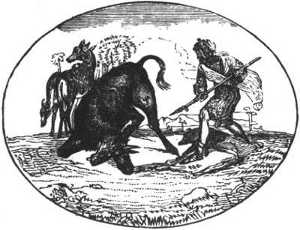

The ox is very much like the bull and the cow in form, size, and color, and lives in the fields as they do. As soon as he is large enough, he is made to work for man; he draws the plough and the wagon, and in old times used to tread out the corn, instead of thrashing as people do now. He is not so wild or fierce as the bull, but its flesh and hide are as useful to us. The ox's foot is of a horny substance, and is called a hoof, like that of the bull and the cow. It is not like the horse's hoof, because it is separated in two. The horns of the ox are64 made into combs, drinking cups, handles for knives, and other things. The blood of the ox is very useful, and when boiled with brown sugar it helps to make it white. The blood also makes a blue dye. Boys should not tease an ox, or throw stones at him. Sometimes they turn on their tormentors, and gore them with their horns.


This is an animal of whom the most ridiculous stories have been told, particularly as to its power of darting its quills to a considerable distance when attacked, and in this manner wounding its enemies. Instead, however of being an enemy to be feared, there is not, perhaps, a more timid creature in existence. But still, as a means of defence, these quills are of great service to their possessor, and preserve it from the attack of most of its enemies; its teeth are very strong and sharp; and if it had courage enough to use them, it would become68 rather a dangerous foe. When full grown, it measures nearly two feet in length. Its general color is a grizzled, dusky black. The upper part of the head and neck is furnished with long light hairs. Most parts of the back and sides are armed with long, sharp pointed quills, which are raised in a threatening manner whenever the animal is excited. The porcupine sleeps during the day, and at night searches for food. Below is a picture of an odd kind of porcupine. It is called a Brazilian porcupine.
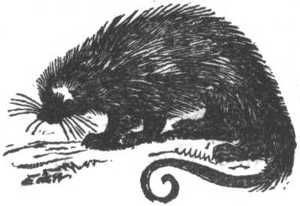

This animal is somewhat like the horse, but most like the zebra, as you may see by comparing the two together. It is found in the southern parts of Africa, living mostly in the plains in large herds. It is not so large or so beautiful as the zebra. Its skin is of a dull brownish white, striped with darker color on the head and neck, and somewhat on the sides of its body; the upper parts of its legs are greyish, and the under parts white. It is a wild creature, and rather vicious in temper. It is made to draw72 by the natives of the country where it is found, and its flesh is eaten by them.
The quagga differs from the zebra in his stripes. You may see by the figure of the zebra, below, that he is striped all over his body and limbs, while the quagga has stripes only on the head and the fore part of the body.


Rabbits are timid little animals, prettily formed, with beautiful long ears. They run swiftly, and jump very nimbly. Wild rabbits live in woods and burrow holes in banks of earth, where they hide themselves from danger. The wild rabbits are of a greyish brown color, but the tame rabbits are white, black, brown, black and white, and reddish. The white have pink eyes. Their fur is soft, and is used for making hats. Their flesh is white and very good to eat. The tame rabbits are kept in very small huts, and little boys and girls are fond of feeding76 them, for they will eat out of their hand, carrots, lettuce, and other green vegetables. Below is a picture of a pretty kind of tame rabbits with very long ears.

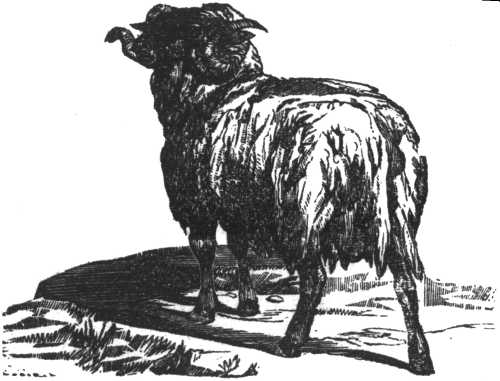
The sheep is perhaps the most useful animal we have in our country; the flesh, called mutton, is most wholesome food. The hair of the skin, called wool, is made into cloth, flannel, and worsted. The skin is made into parchment to write upon, and leather; and from other parts of its body are made the strings for harps and violins, &c. The finest wool is procured from the sheep which are bred in Spain. The sheep is very timid and harmless, and lives as you often may see in flocks, feeding on the grass of the fields and mountains. The hills and mountains80 which are too steep and barren for growing corn afford pasturage for the sheep. It very soon knows the shepherd who is set over it, and is easily guided by him. The young of the sheep are called lambs. Here is a picture of a Scotch shepherd keeping sheep in the Highlands.
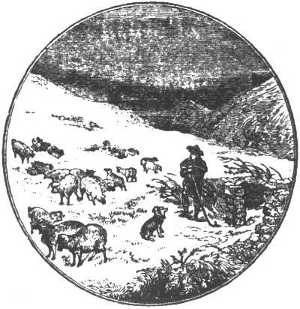

This very beautiful animal, is called a tiger, and is a native of India, a very hot country in Asia. Tigers are very fierce, and will often kill men, and animals a great deal larger than themselves. They live in the woods and thickets, called jungles, where they are hunted. Tigers eat the flesh of animals which they kill. We have none in America, except a few carried about for show. The tiger is as big as a lion, and like the cat in shape, but much larger; he has a long tail, and a handsome striped skin, covered with short hair, which is used for a variety of84 useful and ornamental purposes. He is very active and can spring far. The tiger has sometimes been tamed by menagerie keepers, but he is a very sly and dangerous creature, and never to be trusted.


This name is given to the wild buffalo, of which there are several kinds. The one represented by our picture is the Cape Buffalo, which is found in various parts of Southern Africa. He is a very formidable animal, with spiteful looking eyes, and strong, crooked, sharp horns. He is very strong and hard to kill. The hunters consider him a worse enemy than the lion or the tiger.
This buffalo loves to wallow in pools and swamps, and when the hunters attack him, he charges upon them with his terrible horns, and often overturns a88 horse and his rider, trampling them under his feet, and goring them with his sharp horns.
Mr. Cumming, the English traveller in South Africa, often encountered these animals, and had severe battles with them.
Here is a picture of the American bison, which is commonly called a Buffalo.


The vicugna has sometimes been called the Chilian sheep, from the name of the country it inhabits. It is covered with a fine, valuable wool, which is of a red rose color on the back, but white on the other parts of the body. Vicugnas congregate in large herds, and feed on grass and small shrubs, and so long as they can procure enough of such food, they are never known to drink. They are very timid, but swift and sure at running. Their legs are slender and well formed, and the head tall and erect. Their ears are long and pointed, and their eyes92 large and brilliant. From the form of their feet, they are well fitted to travel mountainous countries, and are said to be even safer than mules. The vicugna is upwards of five feet in height and six in length. The tame ones will carry a load of over fifty pounds, but they are kept principally for the sake of the wool, and the flesh, which is said to taste like mutton. Here is a picture of the llama, which is like the vicugna in many respects.


The wolf is something like a large dog. He is very fierce, and carries off young lambs and kids, which he kills and eats. Throughout Europe there are still many wolves, and the shepherds have great trouble to drive them away from the places where their sheep feed. We see in this picture that the wolf has killed a lamb, and is going to eat him.
We have no wolves in the settled portions of our country, for the whites hunted and killed them all, because they were such troublesome and dangerous neighbors. But in the western country,96 and among the forests and mountains, they are still pretty plenty. Wolves go about in large packs, or companies, and having scented their prey, pursue it like a pack of hounds, uttering the most dismal and ferocious cries.
Below is a picture of a wolf and two cubs.
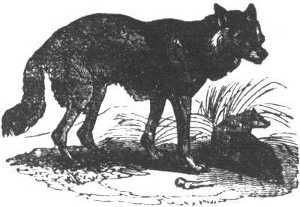

YAK.
We could not procure the drawing of any quadruped whose name begins with this letter.
This animal is seldom seen in Europe, but it is a common one in Tartary, where it is a native. It is like a small ox in its size and form, and has horns and hoofs. Like the ox it is used sometimes as a beast of burden. Its colors are chiefly black and white. The hair is long and rather curly, particularly at its100 tail. The Chinese make ornaments out of the hair of the tails, which they dye various colors and wear them in their bonnets. The Turks and Persians use the tails as we do flags, for war-standards, which they call "horse tails."
The hump on the back of the yak, like that of the bison, is formed of flesh, better flavored and more palatable than any other part of the animal. Hence it is esteemed a great delicacy, and is much prized by the natives of the countries where it is found.


The zebu is an animal of the cow kind, and a native of India, and on that account is often called the Indian ox. There are many varieties of the zebu. Some of them are as large as our largest oxen. Others when full grown are no bigger than a small calf. Its horns are short and thick, and bent a little backwards; there is also a lump on the shoulder, which makes it look clumsy. It is a very useful and docile animal. In India it is used as a common beast of burden; it is also made to draw light wagons, and is even used for riding.104
The Zebu is found not only in India, but in China, Eastern Africa, and the East India Islands. Figures representing the zebu are found on some of the most ancient monuments of that country. The Brahmins esteem the zebu a sacred animal; and for this reason it has received the name of the Brahmin ox.
The picture below, shows several different kinds of zebus.
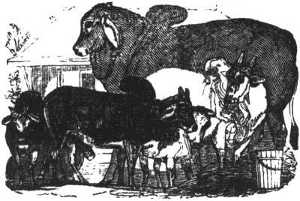

The Alpine Marmot inhabits the Alps, Pyrenees, and other high mountains immediately below the region of perpetual snow. It is about the size of a hare, of a yellowish green color, tinted with an ashen hue about the head; the upper lip is cleft and whiskered. Marmots live in families, who mutually aid each other in excavating a common dwelling,--a chamber lined with dried grass, at the end of a passage, six or eight feet, in the form of the letter Y, one of the branches serving as an entrance, the other as a108 sewer. During winter, the mouth is closed by earth. They feed in company, but always place a sentinel, who, on the first appearance of danger, utters a shrill cry, when the whole retreat.

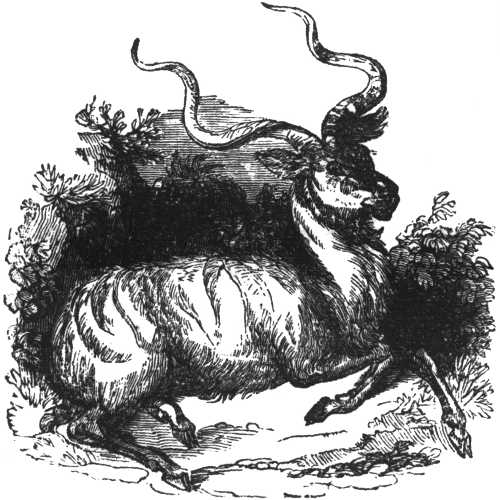
The Koodoo combines many of the characteristics of the sheep, ox, and antelope. He is a large and beautiful animal, a native of the woodlands of Caffraria, the male standing four feet high, and from the insertion of the tail to the muzzle measuring about eight. The horns rise perpendicularly in large spiral whorls, three feet nine inches in length; a bristling of black hairs runs along the ridge of the neck, and a line of the same color hangs from the dewlap: the general color is brown, fading into grey, with112 a dorsal stripe of white, and stripes of the same color behind the shoulders and across the back. They are fleet but can not run long.
More nearly allied to the deer, from which they are distinguished by their horns being permanent and without antlers, but marked with circular elevated rings, which increase, in size with their growth and years, one or two species alone exhibit a short ramification.
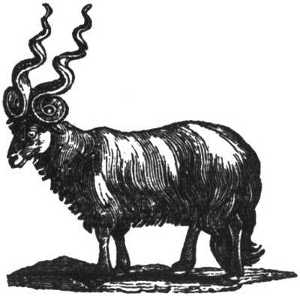

This is a sort of sheep living wild on the mountains of Corsica and Sardinia; a similar species is also scattered over European Turkey and some of the islands of the Archipelago. They are about the ordinary size of sheep, and breed with the domestic races. The head is long, with the muzzle compressed, the nose somewhat raised, and the forehead swollen; the horns of the male (the female being without) are large, long, and triangular, bending backward like a half circle, attenuated from the base to the116 tip, which is obtuse; the body is large and muscular, the tail short, and bare on the inside; the legs are pretty long, and the hoofs short.
They wander in flocks of about a hundred, led by some old and courageous male. Their habits are like those of our own sheep, docile and gentle, though sometimes an amorous or a churlish old ram will butt down a child, a woman, or a man, who may happen to stand in his road, when the fit is upon him.


The European Stag, or Red Deer, is a fine looking animal, the tallest of the deer kind. The pride of the north, he delights in the highest mountains and the thickest forests, and is famed for long life, though the natural term of his existence be often exaggerated, and which, when exposed to human observation, he has never yet been accurately known to reach. He comes to full growth at five years, when his horns send out as many antlers, and he is called a hart, and the female a hind.
Every year the male sheds his horns,120 and conscious of his temporary weakness, hides himself till his new ones are hardened. His color, as his name imports, is a bright reddish-brown, of a darker shade near the belly, which is white. When fatigued in the chase, he takes the water if near, and will cross with ease considerable and rapid streams; when wounded or taken, he sheds tears like a child; but though timid, when at bay he sometimes takes ample vengeance upon the hounds before he is subdued.

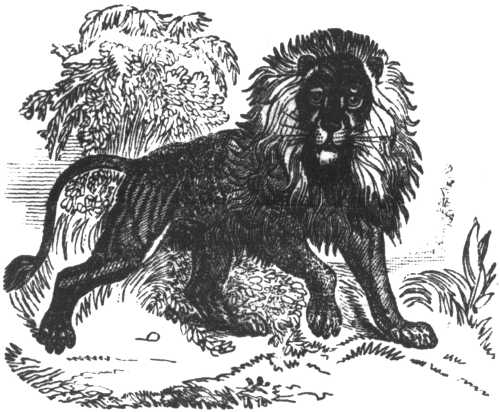
The African Lion, now driven from the coast, is scattered over the interior. He measures from seven to nine feet in length, with a tail about four, tufted at the point; the height at the shoulder from three to five; but when he is newly whelped, his size does not exceed that of a puppy dog, and it requires four, or according to some writers, six years, till he attains his full stature. He lives to a great but uncertain age; one in the Tower reached upwards of seventy years.
124 There are three varieties described; one of a deep yellowish brown; the other of a lighter shade: and the Cape Lion, of which the mane is nearly black. The appearance of the lion, from which he has derived the title of the king of beasts, is majestic when at rest, but terrible when roused. He has a broad face, surrounded with long shaggy hair, and a flowing mane, increasing in length as his years advance, adorns his neck.


The Llama of the New are analogous to the camel of the Old World, but smaller in size, being only about four feet four inches high at the shoulder. The dromedary is from five to seven. It is a native of the mountainous regions of South America. It has cloven hoofs, adapted for aiding its progress in hilly districts. It has no hunch on the back, but has one on the breast. Its color is a greyish-white, spotted. It is equally abstemious in its habits with the camel, and will travel four or even five days without seeking repose; but like the128 camel, it will not be forced to carry more or move faster than it chooses and will rather kill itself, by striking its head on the ground, than be driven forward by harshness or blows. In a wild state it is gregarious, but is easily domesticated, and is still used as a beast of burden.

End of the Project Gutenberg EBook of An Alphabet of Quadrupeds, by Anonymous
*** END OF THIS PROJECT GUTENBERG EBOOK AN ALPHABET OF QUADRUPEDS ***
***** This file should be named 40363-h.htm or 40363-h.zip *****
This and all associated files of various formats will be found in:
http://www.gutenberg.org/4/0/3/6/40363/
Produced by Jason Isbell, Katie Hernandez and the Online
Distributed Proofreading Team at http://www.pgdp.net
Updated editions will replace the previous one--the old editions
will be renamed.
Creating the works from public domain print editions means that no
one owns a United States copyright in these works, so the Foundation
(and you!) can copy and distribute it in the United States without
permission and without paying copyright royalties. Special rules,
set forth in the General Terms of Use part of this license, apply to
copying and distributing Project Gutenberg-tm electronic works to
protect the PROJECT GUTENBERG-tm concept and trademark. Project
Gutenberg is a registered trademark, and may not be used if you
charge for the eBooks, unless you receive specific permission. If you
do not charge anything for copies of this eBook, complying with the
rules is very easy. You may use this eBook for nearly any purpose
such as creation of derivative works, reports, performances and
research. They may be modified and printed and given away--you may do
practically ANYTHING with public domain eBooks. Redistribution is
subject to the trademark license, especially commercial
redistribution.
*** START: FULL LICENSE ***
THE FULL PROJECT GUTENBERG LICENSE
PLEASE READ THIS BEFORE YOU DISTRIBUTE OR USE THIS WORK
To protect the Project Gutenberg-tm mission of promoting the free
distribution of electronic works, by using or distributing this work
(or any other work associated in any way with the phrase "Project
Gutenberg"), you agree to comply with all the terms of the Full Project
Gutenberg-tm License (available with this file or online at
http://gutenberg.org/license).
Section 1. General Terms of Use and Redistributing Project Gutenberg-tm
electronic works
1.A. By reading or using any part of this Project Gutenberg-tm
electronic work, you indicate that you have read, understand, agree to
and accept all the terms of this license and intellectual property
(trademark/copyright) agreement. If you do not agree to abide by all
the terms of this agreement, you must cease using and return or destroy
all copies of Project Gutenberg-tm electronic works in your possession.
If you paid a fee for obtaining a copy of or access to a Project
Gutenberg-tm electronic work and you do not agree to be bound by the
terms of this agreement, you may obtain a refund from the person or
entity to whom you paid the fee as set forth in paragraph 1.E.8.
1.B. "Project Gutenberg" is a registered trademark. It may only be
used on or associated in any way with an electronic work by people who
agree to be bound by the terms of this agreement. There are a few
things that you can do with most Project Gutenberg-tm electronic works
even without complying with the full terms of this agreement. See
paragraph 1.C below. There are a lot of things you can do with Project
Gutenberg-tm electronic works if you follow the terms of this agreement
and help preserve free future access to Project Gutenberg-tm electronic
works. See paragraph 1.E below.
1.C. The Project Gutenberg Literary Archive Foundation ("the Foundation"
or PGLAF), owns a compilation copyright in the collection of Project
Gutenberg-tm electronic works. Nearly all the individual works in the
collection are in the public domain in the United States. If an
individual work is in the public domain in the United States and you are
located in the United States, we do not claim a right to prevent you from
copying, distributing, performing, displaying or creating derivative
works based on the work as long as all references to Project Gutenberg
are removed. Of course, we hope that you will support the Project
Gutenberg-tm mission of promoting free access to electronic works by
freely sharing Project Gutenberg-tm works in compliance with the terms of
this agreement for keeping the Project Gutenberg-tm name associated with
the work. You can easily comply with the terms of this agreement by
keeping this work in the same format with its attached full Project
Gutenberg-tm License when you share it without charge with others.
1.D. The copyright laws of the place where you are located also govern
what you can do with this work. Copyright laws in most countries are in
a constant state of change. If you are outside the United States, check
the laws of your country in addition to the terms of this agreement
before downloading, copying, displaying, performing, distributing or
creating derivative works based on this work or any other Project
Gutenberg-tm work. The Foundation makes no representations concerning
the copyright status of any work in any country outside the United
States.
1.E. Unless you have removed all references to Project Gutenberg:
1.E.1. The following sentence, with active links to, or other immediate
access to, the full Project Gutenberg-tm License must appear prominently
whenever any copy of a Project Gutenberg-tm work (any work on which the
phrase "Project Gutenberg" appears, or with which the phrase "Project
Gutenberg" is associated) is accessed, displayed, performed, viewed,
copied or distributed:
This eBook is for the use of anyone anywhere at no cost and with
almost no restrictions whatsoever. You may copy it, give it away or
re-use it under the terms of the Project Gutenberg License included
with this eBook or online at www.gutenberg.org/license
1.E.2. If an individual Project Gutenberg-tm electronic work is derived
from the public domain (does not contain a notice indicating that it is
posted with permission of the copyright holder), the work can be copied
and distributed to anyone in the United States without paying any fees
or charges. If you are redistributing or providing access to a work
with the phrase "Project Gutenberg" associated with or appearing on the
work, you must comply either with the requirements of paragraphs 1.E.1
through 1.E.7 or obtain permission for the use of the work and the
Project Gutenberg-tm trademark as set forth in paragraphs 1.E.8 or
1.E.9.
1.E.3. If an individual Project Gutenberg-tm electronic work is posted
with the permission of the copyright holder, your use and distribution
must comply with both paragraphs 1.E.1 through 1.E.7 and any additional
terms imposed by the copyright holder. Additional terms will be linked
to the Project Gutenberg-tm License for all works posted with the
permission of the copyright holder found at the beginning of this work.
1.E.4. Do not unlink or detach or remove the full Project Gutenberg-tm
License terms from this work, or any files containing a part of this
work or any other work associated with Project Gutenberg-tm.
1.E.5. Do not copy, display, perform, distribute or redistribute this
electronic work, or any part of this electronic work, without
prominently displaying the sentence set forth in paragraph 1.E.1 with
active links or immediate access to the full terms of the Project
Gutenberg-tm License.
1.E.6. You may convert to and distribute this work in any binary,
compressed, marked up, nonproprietary or proprietary form, including any
word processing or hypertext form. However, if you provide access to or
distribute copies of a Project Gutenberg-tm work in a format other than
"Plain Vanilla ASCII" or other format used in the official version
posted on the official Project Gutenberg-tm web site (www.gutenberg.org),
you must, at no additional cost, fee or expense to the user, provide a
copy, a means of exporting a copy, or a means of obtaining a copy upon
request, of the work in its original "Plain Vanilla ASCII" or other
form. Any alternate format must include the full Project Gutenberg-tm
License as specified in paragraph 1.E.1.
1.E.7. Do not charge a fee for access to, viewing, displaying,
performing, copying or distributing any Project Gutenberg-tm works
unless you comply with paragraph 1.E.8 or 1.E.9.
1.E.8. You may charge a reasonable fee for copies of or providing
access to or distributing Project Gutenberg-tm electronic works provided
that
- You pay a royalty fee of 20% of the gross profits you derive from
the use of Project Gutenberg-tm works calculated using the method
you already use to calculate your applicable taxes. The fee is
owed to the owner of the Project Gutenberg-tm trademark, but he
has agreed to donate royalties under this paragraph to the
Project Gutenberg Literary Archive Foundation. Royalty payments
must be paid within 60 days following each date on which you
prepare (or are legally required to prepare) your periodic tax
returns. Royalty payments should be clearly marked as such and
sent to the Project Gutenberg Literary Archive Foundation at the
address specified in Section 4, "Information about donations to
the Project Gutenberg Literary Archive Foundation."
- You provide a full refund of any money paid by a user who notifies
you in writing (or by e-mail) within 30 days of receipt that s/he
does not agree to the terms of the full Project Gutenberg-tm
License. You must require such a user to return or
destroy all copies of the works possessed in a physical medium
and discontinue all use of and all access to other copies of
Project Gutenberg-tm works.
- You provide, in accordance with paragraph 1.F.3, a full refund of any
money paid for a work or a replacement copy, if a defect in the
electronic work is discovered and reported to you within 90 days
of receipt of the work.
- You comply with all other terms of this agreement for free
distribution of Project Gutenberg-tm works.
1.E.9. If you wish to charge a fee or distribute a Project Gutenberg-tm
electronic work or group of works on different terms than are set
forth in this agreement, you must obtain permission in writing from
both the Project Gutenberg Literary Archive Foundation and Michael
Hart, the owner of the Project Gutenberg-tm trademark. Contact the
Foundation as set forth in Section 3 below.
1.F.
1.F.1. Project Gutenberg volunteers and employees expend considerable
effort to identify, do copyright research on, transcribe and proofread
public domain works in creating the Project Gutenberg-tm
collection. Despite these efforts, Project Gutenberg-tm electronic
works, and the medium on which they may be stored, may contain
"Defects," such as, but not limited to, incomplete, inaccurate or
corrupt data, transcription errors, a copyright or other intellectual
property infringement, a defective or damaged disk or other medium, a
computer virus, or computer codes that damage or cannot be read by
your equipment.
1.F.2. LIMITED WARRANTY, DISCLAIMER OF DAMAGES - Except for the "Right
of Replacement or Refund" described in paragraph 1.F.3, the Project
Gutenberg Literary Archive Foundation, the owner of the Project
Gutenberg-tm trademark, and any other party distributing a Project
Gutenberg-tm electronic work under this agreement, disclaim all
liability to you for damages, costs and expenses, including legal
fees. YOU AGREE THAT YOU HAVE NO REMEDIES FOR NEGLIGENCE, STRICT
LIABILITY, BREACH OF WARRANTY OR BREACH OF CONTRACT EXCEPT THOSE
PROVIDED IN PARAGRAPH 1.F.3. YOU AGREE THAT THE FOUNDATION, THE
TRADEMARK OWNER, AND ANY DISTRIBUTOR UNDER THIS AGREEMENT WILL NOT BE
LIABLE TO YOU FOR ACTUAL, DIRECT, INDIRECT, CONSEQUENTIAL, PUNITIVE OR
INCIDENTAL DAMAGES EVEN IF YOU GIVE NOTICE OF THE POSSIBILITY OF SUCH
DAMAGE.
1.F.3. LIMITED RIGHT OF REPLACEMENT OR REFUND - If you discover a
defect in this electronic work within 90 days of receiving it, you can
receive a refund of the money (if any) you paid for it by sending a
written explanation to the person you received the work from. If you
received the work on a physical medium, you must return the medium with
your written explanation. The person or entity that provided you with
the defective work may elect to provide a replacement copy in lieu of a
refund. If you received the work electronically, the person or entity
providing it to you may choose to give you a second opportunity to
receive the work electronically in lieu of a refund. If the second copy
is also defective, you may demand a refund in writing without further
opportunities to fix the problem.
1.F.4. Except for the limited right of replacement or refund set forth
in paragraph 1.F.3, this work is provided to you 'AS-IS' WITH NO OTHER
WARRANTIES OF ANY KIND, EXPRESS OR IMPLIED, INCLUDING BUT NOT LIMITED TO
WARRANTIES OF MERCHANTIBILITY OR FITNESS FOR ANY PURPOSE.
1.F.5. Some states do not allow disclaimers of certain implied
warranties or the exclusion or limitation of certain types of damages.
If any disclaimer or limitation set forth in this agreement violates the
law of the state applicable to this agreement, the agreement shall be
interpreted to make the maximum disclaimer or limitation permitted by
the applicable state law. The invalidity or unenforceability of any
provision of this agreement shall not void the remaining provisions.
1.F.6. INDEMNITY - You agree to indemnify and hold the Foundation, the
trademark owner, any agent or employee of the Foundation, anyone
providing copies of Project Gutenberg-tm electronic works in accordance
with this agreement, and any volunteers associated with the production,
promotion and distribution of Project Gutenberg-tm electronic works,
harmless from all liability, costs and expenses, including legal fees,
that arise directly or indirectly from any of the following which you do
or cause to occur: (a) distribution of this or any Project Gutenberg-tm
work, (b) alteration, modification, or additions or deletions to any
Project Gutenberg-tm work, and (c) any Defect you cause.
Section 2. Information about the Mission of Project Gutenberg-tm
Project Gutenberg-tm is synonymous with the free distribution of
electronic works in formats readable by the widest variety of computers
including obsolete, old, middle-aged and new computers. It exists
because of the efforts of hundreds of volunteers and donations from
people in all walks of life.
Volunteers and financial support to provide volunteers with the
assistance they need, are critical to reaching Project Gutenberg-tm's
goals and ensuring that the Project Gutenberg-tm collection will
remain freely available for generations to come. In 2001, the Project
Gutenberg Literary Archive Foundation was created to provide a secure
and permanent future for Project Gutenberg-tm and future generations.
To learn more about the Project Gutenberg Literary Archive Foundation
and how your efforts and donations can help, see Sections 3 and 4
and the Foundation web page at http://www.pglaf.org.
Section 3. Information about the Project Gutenberg Literary Archive
Foundation
The Project Gutenberg Literary Archive Foundation is a non profit
501(c)(3) educational corporation organized under the laws of the
state of Mississippi and granted tax exempt status by the Internal
Revenue Service. The Foundation's EIN or federal tax identification
number is 64-6221541. Its 501(c)(3) letter is posted at
http://pglaf.org/fundraising. Contributions to the Project Gutenberg
Literary Archive Foundation are tax deductible to the full extent
permitted by U.S. federal laws and your state's laws.
The Foundation's principal office is located at 4557 Melan Dr. S.
Fairbanks, AK, 99712., but its volunteers and employees are scattered
throughout numerous locations. Its business office is located at
809 North 1500 West, Salt Lake City, UT 84116, (801) 596-1887, email
business@pglaf.org. Email contact links and up to date contact
information can be found at the Foundation's web site and official
page at http://pglaf.org
For additional contact information:
Dr. Gregory B. Newby
Chief Executive and Director
gbnewby@pglaf.org
Section 4. Information about Donations to the Project Gutenberg
Literary Archive Foundation
Project Gutenberg-tm depends upon and cannot survive without wide
spread public support and donations to carry out its mission of
increasing the number of public domain and licensed works that can be
freely distributed in machine readable form accessible by the widest
array of equipment including outdated equipment. Many small donations
($1 to $5,000) are particularly important to maintaining tax exempt
status with the IRS.
The Foundation is committed to complying with the laws regulating
charities and charitable donations in all 50 states of the United
States. Compliance requirements are not uniform and it takes a
considerable effort, much paperwork and many fees to meet and keep up
with these requirements. We do not solicit donations in locations
where we have not received written confirmation of compliance. To
SEND DONATIONS or determine the status of compliance for any
particular state visit http://pglaf.org
While we cannot and do not solicit contributions from states where we
have not met the solicitation requirements, we know of no prohibition
against accepting unsolicited donations from donors in such states who
approach us with offers to donate.
International donations are gratefully accepted, but we cannot make
any statements concerning tax treatment of donations received from
outside the United States. U.S. laws alone swamp our small staff.
Please check the Project Gutenberg Web pages for current donation
methods and addresses. Donations are accepted in a number of other
ways including checks, online payments and credit card donations.
To donate, please visit: http://pglaf.org/donate
Section 5. General Information About Project Gutenberg-tm electronic
works.
Professor Michael S. Hart is the originator of the Project Gutenberg-tm
concept of a library of electronic works that could be freely shared
with anyone. For thirty years, he produced and distributed Project
Gutenberg-tm eBooks with only a loose network of volunteer support.
Project Gutenberg-tm eBooks are often created from several printed
editions, all of which are confirmed as Public Domain in the U.S.
unless a copyright notice is included. Thus, we do not necessarily
keep eBooks in compliance with any particular paper edition.
Most people start at our Web site which has the main PG search facility:
http://www.gutenberg.org
This Web site includes information about Project Gutenberg-tm,
including how to make donations to the Project Gutenberg Literary
Archive Foundation, how to help produce our new eBooks, and how to
subscribe to our email newsletter to hear about new eBooks.